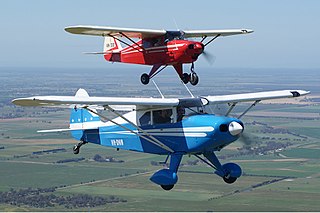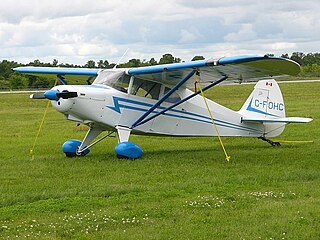Related Research Articles

The Piper PA-28 Cherokee is a family of two-seat or four-seat light aircraft built by Piper Aircraft and designed for flight training, air taxi and personal use. The PA-28 family of aircraft comprises all-metal, unpressurized, single-engined, piston-powered airplanes with low-mounted wings and tricycle landing gear. They have a single door on the right side, which is entered by stepping on the wing.

The Piper PA-32 Cherokee Six is a series of single-engine, fixed landing gear, light aircraft manufactured in the United States by Piper Aircraft between 1965 and 2007.

The Piper PA-23, named Apache and later Aztec, is a four-to-six-seat twin-engined light aircraft aimed at the general aviation market. The United States Navy and military forces in other countries also used it in small numbers. Originally designed in the 1950s by the Stinson Aircraft Company, Piper Aircraft manufactured the Apache and a more powerful version, the Aztec, in the United States from the 1950s to the 1980s.

The Piper PA-24 Comanche is an American four-seat or six-seat, low-wing, all-metal, light aircraft of semi-monocoque construction with tricycle retractable landing gear. Piper Aircraft designed and developed the Comanche, which first flew on May 24, 1956. Together with the PA-30 and PA-39 Twin Comanche, it made up the core of the Piper Aircraft lineup until 1972, when the production lines for both aircraft were wiped out in a flood.

The Piper J-3 Cub is an American light aircraft that was built between 1938 and 1947 by Piper Aircraft. The aircraft has a simple, lightweight design which gives it good low-speed handling properties and short-field performance. The Cub is Piper Aircraft's most-produced model, with nearly 20,000 built in the United States. Its simplicity, affordability and popularity invokes comparisons to the Ford Model T automobile.

The Piper PA-15 Vagabond and PA-17 Vagabond are both two-seat, high-wing, conventional gear light aircraft that were designed for personal use and for flight training and built by Piper Aircraft starting in 1948.

The PA-20 Pacer and PA-22 Tri-Pacer, Caribbean, and Colt are an American family of light strut-braced high-wing monoplane aircraft built by Piper Aircraft from 1949 to 1964.

The Piper PA-34 Seneca is a twin-engined light aircraft, produced in the United States by Piper Aircraft. It has been in non-continuous production since 1971. The Seneca is primarily used for personal and business flying.

The Piper PA-31 Navajo is a family of cabin-class, twin-engined aircraft designed and built by Piper Aircraft for the general aviation market, most using Lycoming engines. It was also license-built in a number of Latin American countries. Targeted at small-scale cargo and feeder liner operations and the corporate market, the aircraft was a success. It continues to prove a popular choice, but due to greatly decreased demand across the general aviation sector in the 1980s, production of the PA-31 ceased in 1984.

The Piper PA-16 Clipper is an extended fuselage model of the PA-15 Vagabond. Both models were designed in 1947 for the same reason – Piper Aircraft found itself in dire financial straits and needed to create new, competitive models using existing parts and tooling. The result was the Vagabond, essentially a side-by-side version of the tandem J-3 Cub credited with saving the company.

The Piper J-5 Cub Cruiser was a larger, more powerful version of the basic Piper J-3 Cub. It was designed just two years after the J-3 Cub, and differed by having a wider fuselage with the pilot sitting in the front seat and two passengers sitting in the rear seat. Equipped with a 75-hp Continental engine the plane's cruising speed was 75 mph. Though officially a three-seater, it would be more accurately described as a "two-and-a-half-seater", as two adults would find themselves quite cramped in the wider rear seat. The Cruiser sold for $1,798 when it was first designed.

The Piper PA-11 Cub Special is a later-production variant of the J-3 Cub manufactured by Piper Aircraft.

The Piper PA-12 Super Cruiser is an American three-seat, high wing, single-engine conventional landing gear-equipped light aircraft that was produced by Piper Aircraft between 1946-48. The PA-12 was an upgraded and redesignated Piper J-5.

The Interstate Cadet was an American two-seat tandem, high wing, single-engine monoplane light aircraft. Around 320 of these aircraft were produced between the years 1941 and 1942 by the Interstate Aircraft and Engineering Corporation based in El Segundo, California. The construction techniques employed were a welded steel tube fuselage, wood (spruce) wing structure with metal ribs, and fabric covering, all of which were fairly standard in the 1940s.

The Franklin O-200 was an American air-cooled aircraft engine of the early 1940s. The engine was of four-cylinder, horizontally-opposed layout and displaced 200 cu in (3 L). The power output ranged between 65 hp (48 kW) and 100 hp (75 kW) depending on variant. The O-200-5 (4ACG-199) featured a geared propeller drive.

The Goodyear GA-2 Duck was a 1940s American three-seat light amphibious aircraft built by the Goodyear Aircraft Corporation. The design team included David Thurston, who later developed several other light seaplanes including the Colonial Skimmer, Lake Buccaneer, Thurston Teal and Seafire. Only 19 aircraft were built, and these were used only for testing and as demonstrators.
The Piper PA-8 Skycycle was a 1940s American single-seat light aircraft designed and built by Piper Aircraft at their Lock Haven, Pennsylvania plant. Towards the end of 1944 Piper announced a number of aircraft it intended to build after the war. One of these was the PWA-8. An aerodynamic test aircraft was built with the name Cub Cycle and it first flew on 27 August 1944 with a small two cylinder Franklin engine. The Franklin engine was replaced by a 37 hp (28 kW) Continental A-40-3 and the aircraft first flew with the Continental engine on 12 September 1944. The Skycycle was a fabric-covered mid-wing single-engined single-seat monoplane with a tailwheel landing gear. The fuselage was produced using a belly fuel tank as used on the F4U Corsair. The Cub Cycle was scrapped and a similar but new aircraft was built with the name Skycycle. The Skycycle first flew on 29 January 1945 using the same Continental engine as the Cub Cycle. The aircraft was further modified in 1945 with a 55 hp (41 kW) Lycoming O-145-A2 engine and designated the PA-8 Skycycle. No further examples were built.
The Piper PA-6 Sky Sedan was a 1940s American four-seat light aircraft designed and built in prototype form by Piper Aircraft at its Lock Haven, Pennsylvania, factory.
The Dätwyler 1038 MDC Trailer was a 1960s Swiss glider tug variant of the American Piper PA-18 Super Cub.

The Aeronca K series, Aeronca Chief, Aeronca Super Chief, Aeronca Tandem, Aeronca Scout, Aeronca Sea Scout, Aeronca Champion and Aeronca Defender were a family of American high-winged light touring aircraft, designed and built starting in the late 1930s by Aeronca Aircraft.
References
- Roger W. Peperell and Colin M.Smith, Piper Aircraft and their forerunners, 1987, Air-Britain (Historians), ISBN 0-85130-149-5, Page 47 and 50.